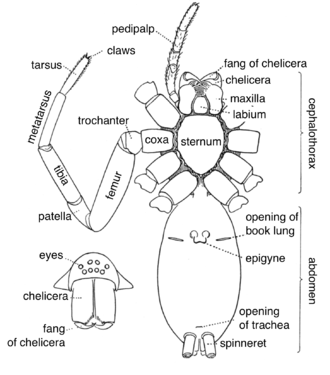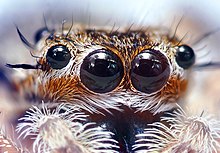Spider anatomy


The anatomy of
Spiders also have several adaptations that distinguish them from other arachnids. All spiders are capable of producing silk of various types, which many species use to build webs to ensnare prey. Most spiders possess venom, which is injected into prey (or defensively, when the spider feels threatened) through the fangs of the chelicerae. Male spiders have specialized pedipalps that are used to transfer sperm to the female during mating. Many species of spiders exhibit a great deal of sexual dimorphism.[1]
External anatomy

Cephalothorax
The cephalothorax, also called prosoma, is composed of two primary surfaces: a dorsal carapace and a ventral sternum. Most external appendages on the spider are attached to the cephalothorax, including the eyes, chelicerae and other mouthparts, pedipalps and legs.
Like other arachnids, spiders are unable to chew their food, so they have a mouth part shaped like a short drinking straw that they use to suck up the liquefied insides of their prey. However, they are able to eat their own silk to recycle proteins needed in the production of new spider webs.[3] Some spiders, such as the dewdrop spiders (Argyrodes), even eat the silk of other spider species.[4]
Appendages
Spiders typically have eight walking legs (insects have six). They do not have
The pedipalps have only six segments: the metatarsus is missing. In adult males, the tarsus of each palp is modified to carry an elaborate and often species-specific structure used for mating (variously called a
Eyes, vision, and sense organs

Spiders usually have eight eyes, each with a single
However, most spiders that lurk on flowers, webs, and other fixed locations waiting for prey tend to have very poor eyesight; instead they possess an extreme sensitivity to vibrations, which aids in prey capture. Vibration sensitive spiders can sense vibrations from such various mediums as the water surface, the soil or their silk threads. Changes in the air pressure can also be detected in search of prey.
Pedicel
The cephalothorax is joined to the abdomen by a thin flexible pedicel. This allows a spider to move its abdomen in all directions, and thus, for example, to spin silk without moving the cephalothorax. This waist is actually the last segment (somite) of the cephalothorax (the pregenital somite) and is lost in most other members of the Arachnida (in scorpions it is only detectable in the embryos).[citation needed]
Abdomen

The abdomen is also known as the opisthosoma. On the ventral side of the abdomen are two hardened plates covering the
Spinnerets
The abdomen has no appendages except from one to four (usually three) modified pairs of movable telescoping organs called spinnerets, which produce silk. Originally, the common ancestor of spiders had four pairs of spinnerets, with two pairs on the tenth body segment and two pairs on the eleventh body segment, located in the middle on the ventral side of the abdomen. The suborder Mesothelae is unique in having only two types of silk glands – thought to be the ancestral condition. All other spiders have the spinnerets further towards the posterior end of the body where they form a small cluster, and the anterior central spinnerets on the tenth segment are lost or reduced (suborder Mygalomorphae), or modified into a specialised and flattened plate called the cribellum (suborder Araneomorphae). The cribellum (usually separated into a left and a right half) produces a thread made up of hundreds to thousands of very fine dry silk fibers (about 10 nm thick) around a few thicker core fibers, which then are combed into a woolly structure by using a group of specialized hairs (setae) on their fourth pair of legs. It is suspected their woolly silk is charged with static electricity, causing its fine fibres to attach to trapped prey. Once all araneomorph (modern) spiders had a cribellum, but today it only remains in the cribellate spiders (although it is sometimes missing even here), which are widespread around the world. Often, this plate lacks the ability to produce silk, and is then called the colulus; an organ that zoologists have not identified a function for. The colulus is reduced or absent in most species. The cribellate spiders were the first spiders to build specialized prey catching webs, later evolving into groups that used the spinnerets solely to make webs, instead using silk threads dotted with droplets of a sticky liquid (like pearls on a necklace) to capture small arthropods, and a few large species even small bats and birds. Other spiders do not build webs at all, but have become active hunters, like the highly successful jumping spiders.
Internal anatomy

Circulation
Spiders, like most
The heart is located in the abdomen a short distance within the middle line of the dorsal body-wall, and above the intestine. Unlike in insects, the heart is not divided into chambers, but consists of a simple tube. The aorta, which supplies haemolymph to the cephalothorax, extends from the anterior end of the heart. Smaller arteries extend from sides and posterior end of the heart. A thin-walled sac, known as the pericardium, completely surrounds the heart.[13]
Breathing
Spiders have developed several different respiratory anatomies, based either on
Among smaller araneomorph spiders there are species in which the anterior pair of book lungs have also evolved into tracheae, or are simply reduced or missing. In a very few species the book lungs have developed deep channels, apparently signs of evolution into tracheae. Some very small spiders in moist and sheltered habitats do not have any breathing organs at all, as gas exchange occurs directly through their body surface. In the tracheal system oxygen interchange is much more efficient, enabling
Digestion

Digestion is carried out internally and externally. Spiders do not have powerful chelicerae, but secrete digestive fluids into their prey from a series of ducts perforating their chelicerae. The coxal glands are excretory organs that lie in the prosoma, and open to the outside at the coxae of the walking legs. In primitive spiders, such as the Mesothelae and the Mygalomorphae, two pairs of coxal glands open onto the posterior side of the first and third coxae. They release a fluid only during feeding and play an important role in ion and water balance.[14] Digestive fluids dissolve the prey's internal tissues. Then the spider feeds by sucking the partially digested fluids out. Other spiders with more powerfully built chelicerae masticate the entire body of their prey and leave behind only a relatively small amount of indigestible materials. Spiders consume only liquid foods. Many spiders will store prey temporarily. Web weaving spiders that have made a shroud of silk to quiet their envenomed prey's death struggles will generally leave them in these shrouds and then consume them at their leisure.
Reproductive system
Almost all spiders
See also
References
- .
- ^ Foelix (1996), p. 37.
- ^ "Spider Silk". UK: School of Chemistry – Bristol University. Retrieved 2007-05-22.
- . Retrieved 2007-05-22.
- ^ Hardy, Maggie (10 January 2016). "Spiders are a treasure trove of scientific wonder". The Conversation. Retrieved 21 April 2022.
- ^ Roberts (1995), pp. 12–16.
- ^ Foelix (1996), p. 24.
- S2CID 21329083.
- ^ "How spiders see the world". Australian Museum. 2015-10-30. Retrieved 2016-09-07.
- ^ Comstock (1920), pp. 128–132.
- ^ Foelix (2011), pp. 39–41.
- ^ Foelix (1996), pp. 53–60.
- ^ Comstock (1920), pp. 148–152.
- ^ Foelix (1996), p. 52.
- .
Bibliography
- Comstock, John Henry (1920) [First published 1912]. The Spider Book. Doubleday, Page & Company.
- Foelix, Rainer F. (1996). Biology of Spiders (2nd ed.). Oxford University Press.
- Foelix, Rainer F. (2011). Biology of Spiders (3rd ed.). Oxford University Press. ISBN 978-0-19-973482-5.
- Roberts, Michael J. (1995). Spiders of Britain & Northern Europe. London: HarperCollins. ISBN 978-0-00-219981-0.
External links
- Griswold, Charles E. (2005). "Atlas of Entelegynae". )
- Levi, H. W. (1965). "Techniques for the study of spider genitalia". Psyche: A Journal of Entomology. 72 (2): 152–158. .
- Eberhard, W.G. & Huber, B.A. (2010). "Spider genitalia: precise maneuvers with a numb structure in a complex lock" (PDF). In Leonard, Janet L. & Córdoba-Aguilar, Alex (eds.). The evolution of primary sexual characters in animals. Oxford University Press. ISBN 978-0-19-971703-3. Archived from the original(PDF) on 2012-07-14. Retrieved 2015-09-20.
- Theraphosidae Belgium, anatomy of bird eaters


